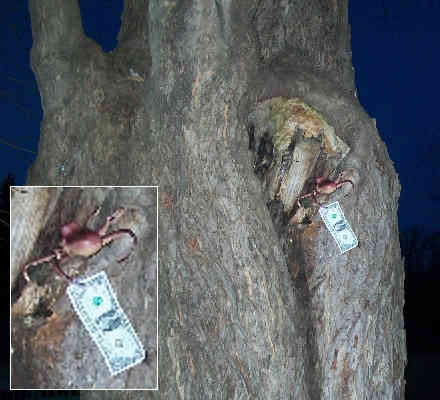#Tree Octopus
Explore tagged Tumblr posts
Text
Did somebody say octopus!

No? Too bad, you get one.
This is Baka-takoak! (Baka tako(stupid octopus)+oak(tree)) he's based on the "northwestern tree octopus"

A sort of "cryptid" that's so obviously fake, it went on to become a tool in teaching American kids about critical thinking in computer class! XD
Those inspirited by this weird wooden octopus suffer from a sudden drop in intelligence. They become dumb enough to believe any scam, lie or conspiracy theory. Never let this thing be in the same room as a politician!
Baka-takoak is an E rank earth attribute. He's a Merican yokai of the Slippery tribe, and has the soultimate "brain strangle" which inspirits his opponents.
I hope you enjoy this literally stupid yokai! And if you do, commissions are open! Details on the blog

63 notes
·
View notes
Text
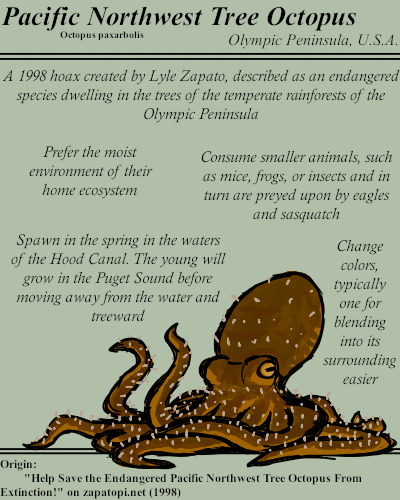
Known as a test of media literacy to some, the story of dwindling population of Washington's tree octopuses is likely one of Lyle Zapato's most famous works. Quite dexterous, these semi-aquatic cephalopods are described as quite well suited to their treetop homes, swinging between branches with their eight appendages.
#BriefBestiary#bestiary#digital art#hoax#fictional animal#tree octopus#pacific northwest tree octopus#octopus paxarbolis#lyle zapato
55 notes
·
View notes
Text

Theme Animal (Tree Octopus)
Prompt List
Creature Codex Art Challenge
Commentary
See now this would've been perfect for yesterday. The tree octopus is a hoax whipped up in the 90s. For this piece I was thinking of rendering of a octopus actually up in a tree but instead decided to go for a travel poster design. I really like it and will be trying to make more in the future.
Palette Picked
50 notes
·
View notes
Text
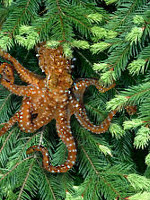
Hoax of the Day: Tree Octopus
Description: You hear something swinging from the trees above you, what could it be? Birds? Squirrels? Or the Pacific Northwest Tree Octopus! No, it’s probably a bird. This internet hoax was created by Lyle Zapato in 1998, and claimed the Washington State Olympic Park was its home.
90 notes
·
View notes
Photo
Originally posted in June 2020.
(IDs added in alt of original post.)
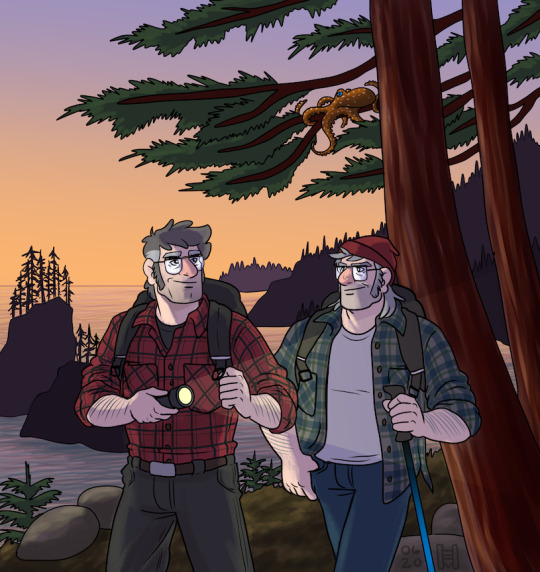
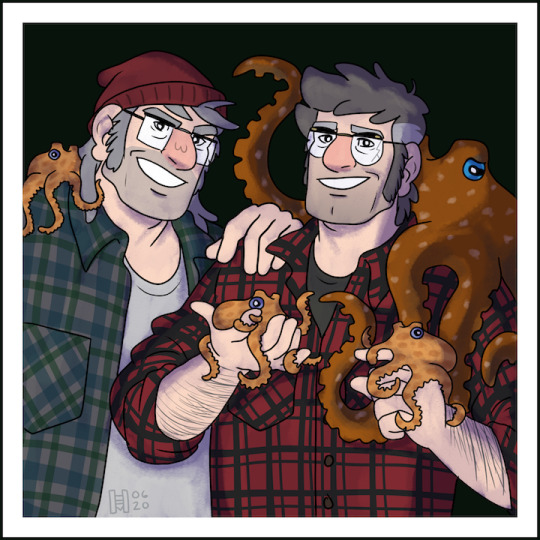
Another Very Happy Birthday to Stan and Ford! (click to embiggen)
Back in 1998, a website appeared entitled “Help Save the Endangered Pacific Northwest Tree Octopus from Extinction”!�� It was a pretty delightful combo of artwork, poorly photoshopped octopi in pine trees, and some really creative write-ups. As a piece of fake-lore, it has attained the dubious honor of actually fooling people into thinking it’s real; so much so that it has its own Snopes page, and has even made it into the Library of Congress! Even if it started as a hoax, many accept it as a legitimate cryptid today.
The original home of the PNW tree octopus is the Olympic peninsula in Washington, across Puget Sound from Seattle. But I decided it would be fun if Ford tracked down rumors that a sub-species has been spotted amongst the coastal Redwoods in California, so he and Stan stopped by there to check it out on their way back to Oregon.
(In the top pic, let’s assume that the adult tree octopus came down to that branch once the boys had passed underneath; otherwise they’re looking very carefully!)
The question remains – will they bring back some babies for Mabel, and the chance to establish a population in Oregon? Hard to resist!
(For this I used refs for the CA and OR coastlines, as well as a number of octopus and tree octopus pics.)
@thestanbros
#gravity falls#stanford pines#stanley pines#sea grunks!#tree octopus#my art#ids in alt#stan twins birthday
903 notes
·
View notes
Text


Autumn comes
You know that weird inbetween autumn and winter vibe? Ye, this goes by Autumn collection #6, which I couldn't finish in time from last year! Tho I did this in february so it's also Winter col. #2 lol.
#his button nose💙#since I drew Pickles' octopus like hair I tried to frame him with Nathan's hair symbolizing a crocodile's teeth&jaw#I just had to draw them together in a green environment. it's meant to be a swamp in Florida where the trees stay green#and where the water doesn't reach them atm#they're gonna be so muddy though#this kinda reminds me of Ori and the franchise in colors#mtl#metalocalypse#dethklok#pickles the drummer#mtl fanart#nathan explosion#metalocalypse fanart#dethklok fanart#mtl artwork#nickles
259 notes
·
View notes
Text

Octopus tree
#forest#nature#beauty#photographers on tumblr#artists on tumblr#original photographers#original photography#photography#aesthetic#Washington#pnw#westcoastbestcoast#art#vsco#pacific northwest#explore#travel#cottagecore#naturecore#grandmacore#p#as opposed to a tree octopus#'
475 notes
·
View notes
Text
I actually have these as part of a small spec evo project I've got going on - I'll be sure to remember this when I get to them!
Today I want to talk about the Pacific Northwest Tree Octopus (Octopus paxarbolis).
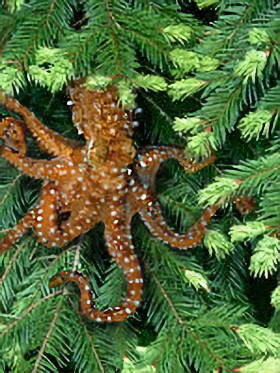
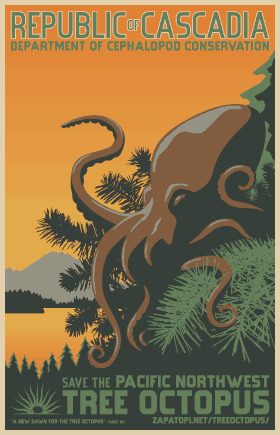
OK, so for those who don't know, the PNW Tree Octopus was an internet hoax created in 1998 consisting of a website detailing the animal's life history and conservation efforts. It's completely fake - saying that up front. This animal never existed.
But if you look at this from a speculative biology standpoint? It's genius.
There is one, and only one, thing preventing Octopus from colonizing and being hugely successful in terrestrial environments in the PNW, and that's the fact that no cephalopod has ever been able to overcome the osmotic stress of inhabiting freshwater. We don't know why this is; other mollusks evolved freshwater forms just fine. But if you hand-wave away that one, single limiting factor, the PNW is just primed for a terrestrial octopus invasion.
The Pacific coast of North America is an active tectonic boundary, meaning the coast transitions pretty much immediately into the Cascade and Coastal mountain ranges (contrast with the east coast and its broad Atlantic plain). It's also a lush temperate rainforest, with very high precipitation. This means lots and lots of high-gradient mountain streams with lots of waterfalls and rapids and cold, highly oxygenated water, and not as many large, meandering rivers.
This has important consequences on the freshwater fauna. For one, there are not many freshwater fish in the Pacific Northwest - the rapids and waterfalls are extremely hard to traverse, so many mountain streams are fish-free. There also just isn't much fish diversity in the first place - there's sturgeon in the big rivers, salmonids, a few sculpin and cyprinids and... that's pretty much it. These cold northern rivers are positively impoverished compared to the thriving fish communities of the Mississippi or Rio Grande.
Few fish means few predators, and depending on the size of the first freshwater octopus, salmon and trout just wouldn't be much of a threat. And while these rivers don't have much in the way of fish diversity, there's lots of prey available - crayfish, leeches, mosquito larvae, frogs and tadpoles, water striders, and other aquatic insects, just to name a few. So the first Octopus pioneers to invade the rivers would be entering what essentially amounts to a predator-free environment with lots and lots of food and no competition. Great for colonization.
These ideal conditions get even better once you get up past the rapids and waterfalls, since there's no fish whatsoever in those streams. Octopus, with their sucker-lined arms, are perfectly equipped to navigate fast-moving, rocky-bedded streams and climb up cliffs. They'd also be well able to traverse short stretches of dry ground to access even more isolated pools and ponds. In fact, once Octopus overcome the osmoregulation problem there's nothing at all preventing them from colonizing land in earnest, since the PNW rainforests are so wet; there's no danger of drying out.
Finally there's the question of reproduction. Octopus are famously attentive mothers, because they need to keep the water around their eggs moving and well-oxygenated. In a mountain stream, this wouldn't be an issue, because the cold, turbulent water holds lots and lots of oxygen. Breeding in high mountain streams would be ideal, and the mothers might not even need to attend to their eggs, freeing them up to evolve away from semelparity and allowing them to reproduce more than once in their lives; their populations would thus increase rapidly and dramatically.
I think, if octopus managed to invade freshwater ecosystems in the PNW, it would dramatically change the ecology much like an invasive species. They'd be unstoppable predators of frogs, bugs, slugs, maybe even larger animals like snakes, birds, and small mammals. Nothing would eat them except maybe herons, and things like bears and raccoons would give them a wide berth due to their venom. They would rule that landscape.
The tl;dr is that the PNW is primed for invasion by cephalopods, if only they could manage to overcome the osmoregulation problem and live in freshwater. If the Pacific Northwest Tree Octopus really did exist, it wouldn't be a shy and reclusive species on the brink of extinction; it would be a pest, an invasive, overpopulated menace you couldn't get rid of if you wanted to. I can just imagine them crawling up onto people's bird feeders and either stealing the nuts or luring in unsuspecting sparrows and starlings. They would sit in the trees and throw pinecones at hikers for fun. They would be some unholy mixture of snake and slug with the personality of a magpie and I am incensed that they only exist in fiction.
319 notes
·
View notes
Text


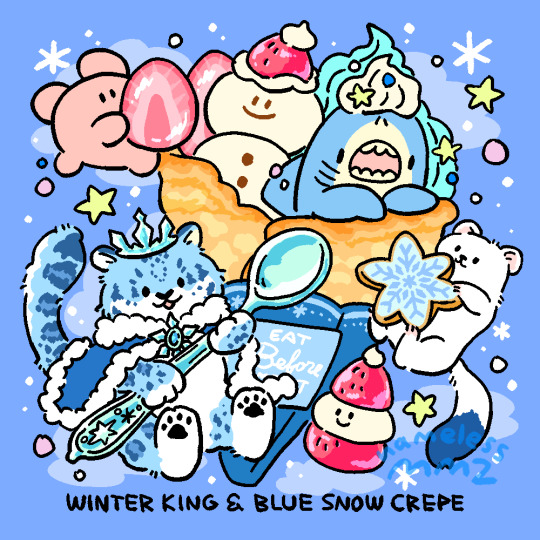
MerryDelishcember 2024!
Day 6 Tinsel/Ribbon / Day 7 Tree / Day 8 Winter King/Queen
#merrydelishcember2024#merrydelishcember#illustration#drawing#cute art#kawaii#art#cute food art#shark#flapjack octopus#holidayseason#crepe#reindeer#christmas tree#snow leopard
187 notes
·
View notes
Text




preorders open until November 29th on these guys! the isopod phone charms went super fast last time so a preorder seemed to be in order to keep up with demand - I added panda kings to the lineup as well. and some fun shaker charms too!
#my art#digital art#queer artist#insect#bugs#marine biology#frog#tree frog#octopus#cephalopod#zoology#aquarium#spotted lanternfly#entomology#isopods#crab
152 notes
·
View notes
Text
Wings of Fire Worldbuilding: Royal SeaWing Family Tree [3011-3017AS; 4990-5012AS]
"The Royal SeaWings have had a tumultuous history, though there are long periods where not much was recorded aside from names. To keep everything concise, I've only gathered the two most famous eras of the royals- the time of the Great SeaWing Massacre and the time of the Dragonets of Destiny. It should also be noted that, due to his self-imposed exile and separation from the royals, descendants of Prince Fathom and Indigo's dragonets are unknown. "- June Beetle, historian
3011-3017AS
Gen 1: Prince Albatross, Princess Sapphire, Queen Lagoon, King Consort Humpback
Gen 2: Prince Eel, Princess Manta, Prince Consort Reef, Princess Splash
Gen 3: Prince Current, Prince Scallop, Queen Pearl, Prince Fathom, Indigo
Gen 4: Princess Clearpool, Prince Cowrie, Prince Ripple
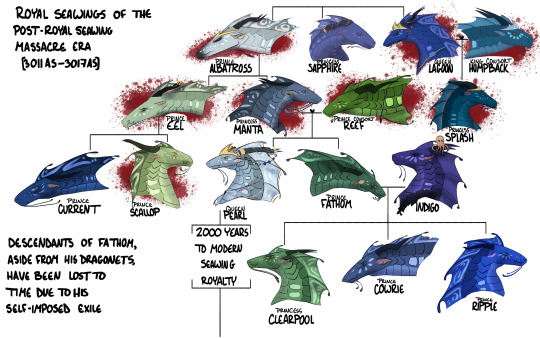
Eel, Albatross, Manta, Lagoon, Humpback, Manta, Reef, Splash, and Scallop were killed in the Royal SeaWing Massacre of 3011AS
4990-5012AS
Gen 1: Prince Shark, Queen Coral, King Consort Gill
Gen 2: Princess Moray, Prince Turtle, Princess Anemone, Princess Orca, Prince Octopus, Prince Fin, Princess Auklet, Prince Cerulean, Princess Tsunami
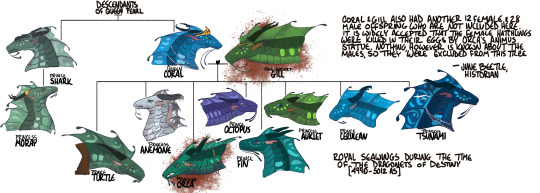
The unnamed 12 female and 28 male offspring of Coral and Gill are not included in this family tree. We historians assume that the female offspring died in the egg, but the lives of the princes are not known. Did they die in the egg like their sisters? We don't think so, but their names and stories have been lost to us.
#wof#sotw au#wings of fire#wingsoffire#wings of fire headcanons#wings of fire headcanon#wof au#seawings family tree#royal seawing family tree#prince shark#queen coral#queen coral wof#king gill#king gill wof#gill wof#moray wof#princess moray#turtle wof#shark wof#princess anemone wof#anemone wof#prince turtle wof#princess orca wof#princess orca#orca wof#octopus wof#prince octopus#prince octopus wof#auklet wof#princess aulket wof
27 notes
·
View notes
Text
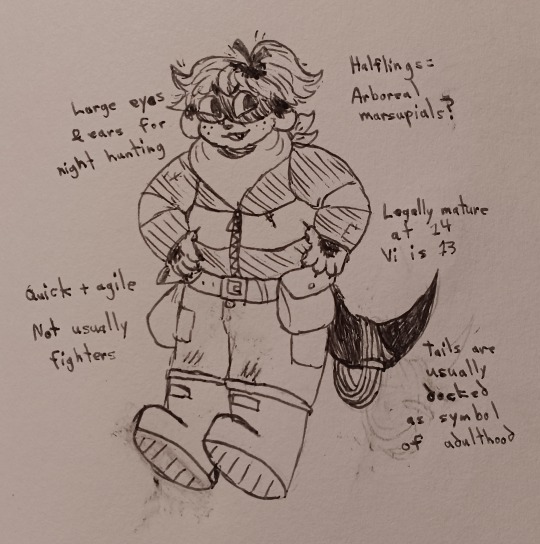
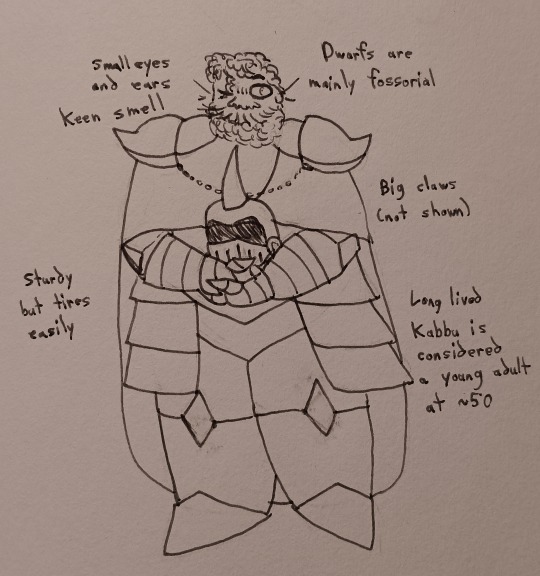

team snakemouth gijinka but more of a Fantasy™️ au than just regular humans. featuring our spin on the concepts of halflings and dwarves where they are creature animal. and leif is uh ??? the horrors
bonus doodle

#bug fables#bug fables spoilers#bf vi#bf kabbu#bf leif#gijinka#stuff i made tag#we have never showed the face of our kabbu gijinka before now#we just don't think he's meant to be de-helmeted but it was necessary to show off his funky mole nose and whiskers#most of leif's octopus features are still covered by their clothes though. nobody needs to see that#the bee (halfling) kingdom still lives in a tree like usual#vi here is based on tasmanian devils but they're mostly inspired by possums and the like#the parts about their ages were only included because we think it's funny#vi says she's 13 and means 'im almost an adult' but kabbu hears 'that is a TODDLER'#we have even more thoughts about the setting in general but we should. read more of the thing that inspired this first#about 40 chapters to go... hooray (this is fun to read we are not actually complaining)
69 notes
·
View notes
Text

MEANWHILE
PAGE 2
First - Next - Back
GO BACK
#Sugar's the Pacific tree octopus on Mason's head#The pet all young boys want of course.#comic#miitopia fanart#fanart#miitopia
7 notes
·
View notes
Text
The Pacific Northwest Tree Octopus is a hoax made by Lyle Zapato. It describes an octopus adapted to live in trees, and its predator is the Sasquatch, an unreal creature.


Gowever, as it turns out, land octopi do exist.
The Midwestern land-octopus is a type of mollusc directly descended from octopi, some 50 million years ago, when it adapted for life on land. It’s native habitat is in the United States of America and Canada. Specifically the states of Minnesota, North Dakota and the Canadian province of Manitoba.
It looks radically different from its octopi kin, looking more like a slug than anything else. Its connection to the Octopoda order was only discovered in 2021 after genetic testing revealed that it was genetically distinct from other slug species, but most similar to an octopus.

References
Lyle Zapota. https://zapatopi.net/treeoctopus/
Benoit Baudry and Martin Monperrus. https://doi.org/10.48550/arXiv.2204.06826
17 notes
·
View notes
